Observed by Women Date July/August/September | Type of holiday Religious celebration | |
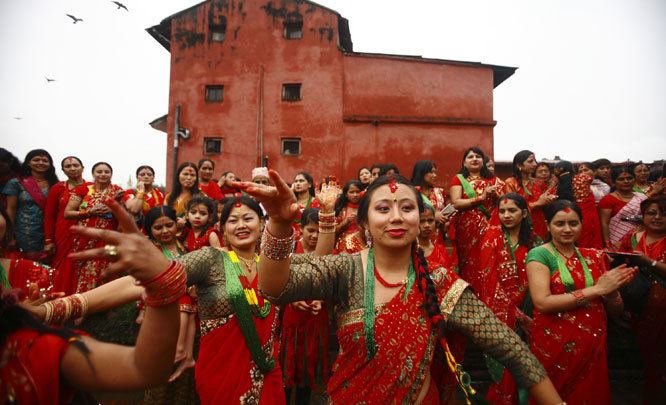 | ||
Begins Haryali Teej: Third day of the bright half of the lunar month of Shraavana. Kajari Teej: the third day of the dark fortnight of Bhadrapada. Hartalika Teej: third day of the bright half of Bhadrapada. 2016 date Haryali Teej: 5 August Kajari Teej: 21 August Hartalika Teej: 4 September Observances Fasting Festival for Women Also called Monsoon Festival/Dedicated to Goddess Parvati | ||
Teej is a generic name for a number of festivals that are celebrated in Nepal, Northern and Western India. Haryali Teej, Kajari Teej and Hartalika Teej welcome the monsoon season and are celebrated primarily by girls and women, with songs, dancing and prayer rituals. The monsoon festivals of Teej are primarily dedicated to Goddess Parvati and her union with Lord Shiva.
Contents
- Teej festival culture of nepal
- Description
- The types of Teej
- Haryali Teej
- Punjab region
- Rajasthan
- Kajari Teej
- Hartalika Teej
- Gujarat
- Kevada Teej
- Akha Teej
- Awra Teej
- Tay or Tayi
- Kajal Teej of Andhra Pradesh
- Jhulan Utsav
- Observance in Nepal of Hartalika Teej
- Day One
- Day Two
- Day Three
- Sindh
- References
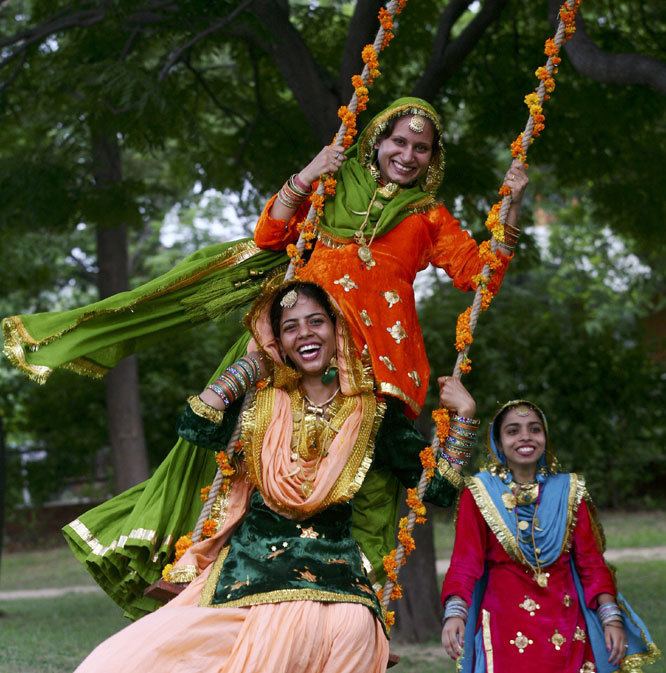
Teej festival culture of nepal
Description

Teej refers to the monsoon festivals, observed particularly in western and northern states of India and Nepal. The festivals celebrate the bounty of nature, arrival of clouds and rain, greenery and birds with social activity, rituals and customs.
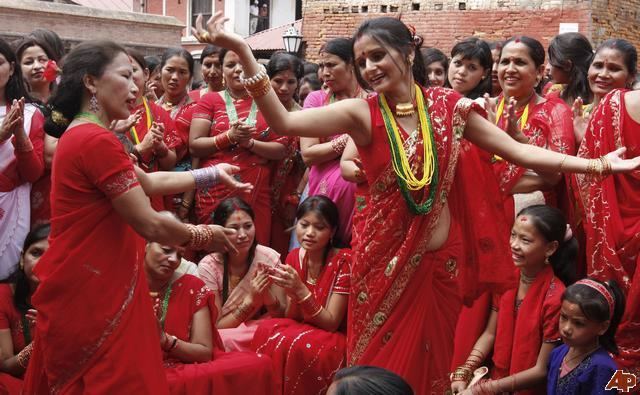
The festivals for women, include dancing, singing, getting together with friends and telling stories, dressing up with henna-coloured hands and feet, wearing red, green or yellow clothes, sharing festive foods, and playing under trees on swings on Haryali Teej.
The festivals are dedicated, in many parts of India and Nepal, to Parvati.
The types of Teej
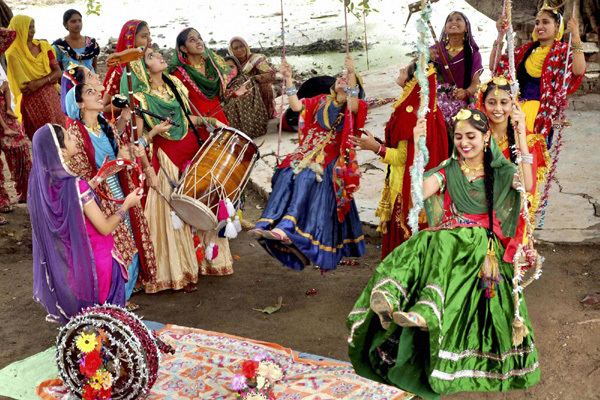
"Teej" refers to the "third" day that falls every month after the new moon (Amavasya), and the third day after the full moon night of every month. The monsoon festivals of Teej include Haryali Teej, Kajari Teej and Hartalika Teej.
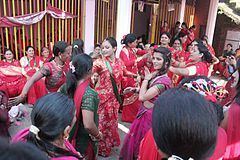
Teej festivals are traditionally observed by women to celebrate the monsoons, on the third day of the Indian month of Shravan, and on the third days of the waning and waxing moon of the Indian month of Bhadrapud. Women also pray to goddess Parvati seeking the wellness of their husband, children and their own self.
Haryali Teej
Haryali Teej is celebrated on the third day of the bright half of the North Indian Lunar month of Shraavana. As Shraavana (or Saawan) month falls during monsoon or rainy season when the surroundings become green, the Shraavana Teej is also called Hariyali Teej (Green Teej). A fast is kept and the focus is the moon.
The Hariyali Teej festival is also celebrated to remember the reunion of Lord Shiva and Goddess Parvati, the day when Lord Shiva accepted Goddess Parvati as his wife. Goddess Parvati fasted and was austere for many years and was accepted by Lord Shiva as his wife in her 108 birth. Goddess Parvati is also known as Teej Mata.
Sindhara Teej: On Teej festival married daughters receive the gifts by her mother such clothes, bangles, bindi, mehandi etc. "Ghewar" a special sweet is given to her on this day. These gifts are known as Sindhara
The traditional areas of celebration are: Punjab region and Rajasthan.
Punjab region
The festival is celebrated in Punjab, Haryana and Chandigarh.
Punjab
Teej is known as teeyan in Punjab and is seen as a seasonal festival which is dedicated to the onset of the monsoon. The festival is celebrated by women of all faiths, and lasts from the third day of the bright half of the lunar month of Sawan as per the Punjabi calendar to the full moon of Sawan (about 13 days). Teeyan involves women getting together and performing Gidda, married women visiting their families and receiving gifts. It is also traditional for women to ride on swings.
Fairs are organised in Schools and Colleges where dance competitions are held.
Haryana
Haryali Teej is one of the famous festivals of Haryana, and is celebrated as an official holiday. Many functions are organised by the Government of Haryana to celebrate this festival, which welcomes the rainy season. Boys traditionally flew kites from morning to evening, though this tradition is losing its charm in big cities due to high rise buildings and lack of terrace space.
Swings are set up in open courtyards, under trees for the season. Girls apply henna to their hands and feet and are excused from household chores on this day. On Teej, girls often receive new clothes from their parents.
On Teej, just as on Karva Chauth, the mother sends a baya or gift. The puja is performed in the morning. The baya, which consists of a variety of foodstuffs, is placed on a thaali at a place of worship where a chowk (square) has been decorated, and an idol or picture of Parvati has been installed. The evenings are set aside for singing and dancing, including the women's prayers for their husbands' longevity and their families.
Chandigarh
Chandigarh administration makes special arrangements for Teej celebration in the Rock Garden in the city. School children present plays and other cultural programs on this day. The female members of the family, especially daughters, are given gifts and dresses.
Rajasthan
Teej welcomes the monsoon and observed in the month of Shravan (July/August). The monsoon rains fall on the parched land and the pleasing scent of the wet soil rises into the air. Swings are hung from trees and women dressed in green clothes sing songs in celebration of the advent of the monsoon.
This festival is dedicated to the Goddess Parvati, commemorating her union with Lord Shiva. Goddess Parvati is worshipped by seekers of conjugal bliss and happiness. An elaborate procession is taken out in Jaipur for two consecutive days on the festive occasion which is watched by people in large numbers. The Teej idol is covered with a canopy whereas the Gangaur idol is open. The traditional ghevar sweet is also associated with the festival.
During Teej, Goddess Parvati is worshipped. The day before Haryali Teej, is celebrated as Sinjara, wherein women put mehandi on their hands and eat .
Marwari community of Rajasthan
Teej is an important festival amongst the Marwari communities of Rajasthan. Women wear bangles and bindis. Swings are put on trees for the entertainment of girls. Amongst the Baniyas and Marwaris, the festival is a celebration for women, especially girls who are usually given gifts like new clothes. A special lunch is organized by women for themselves. It is customary for mothers-in-law to give a new daughter-in-law a piece of jewellery on her first Teej after marriage.
Traditionally, a married woman would go to her mother's house for Teej and come back after Rakhi. In this way they would spend about 10 days of the summer with their parents. It is customary that, when a daughter goes to her parents' house, she takes sweet and salty savouries with her.
Daughters spend Teej with their parents. After they come back they spend Buddhi Teej — Teej for the daughters-in-law — in their marital home. Buddhi Teej normally falls within a week after Rakhi.
On this day a special sweet called sattu is made for unmarried girls, which she can eat after seeing the moon at night.
Kajari Teej
Kajarai teej is celebrated in the North Indian Lunar month of Bhadrapud: the third day of the dark fortnight of Bhadrapada. Kajari teej is also called boorhi teej. In Rajasthan, kajarai teej is referred to badi (bigger) teej which follows haryali teej, known as chhoti (smaller) teej.
Women in Uttar Pradesh pray to Lord Shiva on kajari teej. It is also customary to sing folk songs known as kajris. The focus of the lyrics is usually on separation expressing the pining of a woman for her beloved in her parents' home, where she has been sent to celebrate teej, or waiting in anticipation to be collected by brothers to celebrate teej. The kajri is a folk song composed and sung in the regions of eastern Uttar Pradesh, Bihar and in parts of Madhya Pradesh and Rajasthan.
Women who observe the kajari teej fast go without food and water. kajari teej is also known as kajali teej which also involves praying to the moon. The fast is broken by eating sattu. The other focus of the day is to pray to the neem tree (Azadirachta indica). A fair is held in Bundi in Rajasthan to celebrate Kajari teej.
Hartalika Teej
Hartalika is a combination of "harit" and "aalika" which means "abduction" and "female friend" respectively. According to the legend of Hartalika Teej, Goddess Parvati, incarnated as Goddess Shailaputri, was the daughter of himalaya who promised her hand in marriage to Lord Vishnu, at the suggestion of Narada. Upon hearing this, Goddess Parvati told her friend of her father's decision whereupon the friend took Goddess Parvati to the thick forest so that her father would not marry her to Lord Vishnu against her wish.
On the third day of the bright half of Bhadrapud, Goddess Parvati made a Shiva lingam out of her hair and prayed. Lord Shiva was so impressed that he gave his word to marry Goddess Parvati. Eventually, Goddess Parvati was united with Lord Shiva and was married to him with her father's blessing. Since then, the day is referred to as haritalika teej as Goddess Parvati's female (aalika)friend had to abduct (harit) her in order for the Goddess to achieve her goal of marrying Lord Shiva.
Accordingly, Hartalika Teej is seen as a major festival and is celebrated on the third day of the bright half of the North Indian Lunar month of Bhadrapud. The festival women feasting during the evening of Hartalika Teej, praying to Goddess Parvati and Lord Shiva, remembering their wedding and staying up all night listening to prayers. The fast (also called nishivasar nirjala vrat) commences during the evening of Hartalika Teej and is broken the next day after a full day's observance which involves women not even drinking water. The focus is on praying to Goddess Parvati whom Shiva desired should be worshipped under the name Hartalika.
The main areas of celebration are Rajasthan, Uttar Pradesh, Uttarakhand, Bihar and Jharkhand. In Rajasthan, an idol of Goddess Parvati is taken out in procession in the streets accompanied by singing, and music. The Hartalika Teej festival has also spread to parts of Madhya Pradesh where it is celebrated as a minor festival. The next Hartalika Teej will be on 4 September 2016.
Hartalika Teej of the north is not to be confused with Hartalika Teej of Maharashtra which is connected to the festival of Gowri Habba.
Gujarat
Gujaratis have adopted the festival of Haryali Teej which is celebrated in Gujarat in a like manner to Rajasthan.
Kevada Teej
Kevada Teej, also known as Kevda Trij, is a festival observed mainly in Gujarat. The festival is celebrated on the third day of the Shukla Paksha (waxing phase of moon) of Bhadra in Gujarat. This observance is similar to the Hartalika Teej Vrat. Married and unmarried women observe a fast on the day and offer Kevada flower (Pandanus: pine screw) to Goddess Parvati and Lord Shiva.
Akha Teej
Akha Teej (also called Akshaya Tritiya) falls on the third lunar day of the bright half of Indian month of Vaishakha . It is an auspicious day of the birthday of Lord Parasurama who is the sixth incarnation of Lord Vishnu. On this day Veda Vyas and Lord Ganesha began to write Mahabharata. Jains celebrate this day to commemorate Tirthankara Rishabha's ending of one-year fast by consuming sugarcane juice poured into his cupped hands. Akha Teej is observed in many parts of South Asia.
Awra Teej
Awra Teej is celebrated in the lunar month of Vaisakh in parts of Madhya Pradesh and Chhattisgarh: Awra Teej is not associated with the trio of the monsoon festivals of Teej as the month of Vaisakh occurs during spring.
Tay or Tayi
Tay/Tayi is celebrated in Goa and by other Konkanis in Karnataka, and Kerala.
Kajal Teej of Andhra Pradesh
Teej in Andhra Pradesh forms part of a wider celebration which is a forerunner to other festivals being celebrated and is known as Kajal Teej. Kajal Teej is one of the Banjara tribe's biggest festivals. It is quite popular in villages and thandas. It is a week-long festival. On day 1 unmarried girls put wheat on a small bamboo basket. On the 7th day of sowing, the festival of Thamoli is celebrated. On the ninth day, an earthern idol is prepared which is taken with all the bamboo baskets in a procession and immersed in a nearby pond or river.
Jhulan Utsav
Haryali Teej coincides with the swing festival of 'Jhulan Leela' also known as 'Jhulan Utsav' or 'Hindola Utsav' which is associated with Krishna and Radha, and is celebrated at Banke Bihari Temple and other Temples in the Vrindavan area of Uttar Pradesh. The festival lasts until Krishna Janmashtami for 13 days.
On the day of Teej, idols of Krishna and Radha are placed on swings in the Temples and the focus of Jhullan Leela is religious. The green theme, popular in neighbouring Rajasthan and Haryana on Haryali Teej, can also be seen in the Jhulan Utsov. Idols of Krishna and Radha are dressed in green clothes.
Haryali Teej and Jhulan Ustav fall on the same day. However, Haryali Teej is a monsoon festival dedicated to Goddess Parvati whereas, Jhulan Utsav is dedicated to Lord Krishna and Radha.
Observance in Nepal of Hartalika Teej
Dedicated to the Goddess Parvati, commemorating her union with Lord Shiva, the festival is celebrated for well-being of spouse and children and purification of one's body and soul. The festival is a three-day-long celebration that combines sumptuous feasts as well as rigid fasting. Teej is celebrated by women, for the long life of her husband and long and firm relationship between them in this life and all the lives to come.
The folk music and dances add more flavor to traditional values of Teej. Women in red dance and sing in the street, going to temple in holy and fasting mood. Teej is also called Haritalika Teej. This festival is celebrated by Nepali Hindu women all across the world.
Day One
The first day of Teej is called Dar Khane Din. On this day the women assemble at one place in their finest attire and start dancing and singing devotional songs. Amidst all this, the grand feast takes place. What is unusual about this day is that the feast is hosted by men. Women, who work hard throughout the year, do not have to do anything that day. That is the day for them to embellish themselves in sorha singaar — dressing up and using make up to the full extent, indulge in good food, and dance. Oftentimes, because women are invited by multiple brothers for the feast, they try to dance off some food before they are ready to eat more. The food served is supposed to be rich and abundant.
This is probably the only day in a year that allows women full freedom of expression. Consequently, women have traditionally used this occasion to express their pains and pang in the songs they sing while dancing. With the advancement of communication and awareness, women these days use this occasion to voice their concerns about social issues and discrimination against women. The jollity often goes on till midnight, after which the 24-hour fast starts.
Day Two
The second day is the fasting day. Some women live without food and drops of water while others take liquid and fruit. The fasting is observed by married and unmarried women. Married women abstain strictly from food and drinks with a believe that their devotion to the god will be blessed with longevity, peace and prosperity of their husband and family. Unmarried women observe the fast with a hope of being blessed with a good husband.
They dress gaily and visit a nearby Shiva temple singing and dancing on the way. The Pashupatinath Temple gets the highest number of devotees. At the temple, women circumambulate the Shiva Lingam, which symbolizes Lord Shiva, offers the praying with flowers, sweets and coins. The main puja (religious ceremony) takes place with offerings of flowers, fruits, etc., made to Shiva and his wife goddess Parvati, beseeching them to grant their blessing upon the husband and family. The important part of the puja is the oil lamp which should be alight throughout the night. It is believed that by the light of an oil lamp all night will bring peace and prosperity to the husband and family.
Day Three
The third day of the festival is Rishi Panchami. After the completion of the previous day's puja, women pay homage to seven saints or sages, offer prayers to deities, and bathe with red mud found on the roots of the sacred datiwan bush, along with its leaves. This act of purification is the final ritual of Teej, after which women are considered absolved from all their sins. Recent years have witnessed an alteration in the rituals, especially concerning the severity, but its essence remains the same.
Sindh
The Sindhi community in India celebrate Teej which is known as Teejri. However, Sindhis celebrate Teejri on the third day after the full moon of Sawan.
